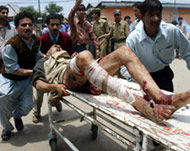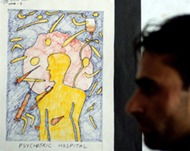Kashmir victims undergo art therapy
When art therapist Arshad Hussain gave a patient at revolt-hit Indian-administered Kashmir’s lone psychiatric hospital a canvas, the painting she produced was graphic and disturbing.

Twenty-four-year-old Hanifa Akhter, who saw her brother shot and killed before her, “rubbed her fingers with red paint, pressed them on the canvas and said, ‘Khoon kay panjay’ (hands of blood),” Hussain recalled.
Her painting was among works by 60 patients at the Psychiatric Diseases Hospital displayed this month at a show in Srinagar, the main city in Indian Kashmir where thousands of people have died in a 16-year revolt.
Art is being used as a key therapy to try to help traumatised Kashmiris recover from the torment of living in the midst of one of the world’s deadliest conflicts, where eight to 10 people die daily in separatist-related violence.
“Art therapy serves two purposes. It helps patients relax and work through their trauma. Secondly, through their art, we can follow the progress of their recovery,” said Hussain, who works for Geneva-based Medecins Sans Frontieres or Doctors without Borders.
Recovery
An early drawing by another patient, Zohra, who was also 24 when she was admitted to hospital after seeing a close relative killed in front of her, is a tortured scrawl of swirling lines in a single colour – green.
 |
|
More than 44,000 people have |
But in a later abstract daub, she uses a palette of cheery colours – red, yellow, green and blue – showing her despair is lifting, Hussain said.
“We can clearly see Zohra is recovering,” he said, pointing to one of her works at the show.
Both patients have since been released from hospital.
While they were helped, doctors say many like them receive no assistance.
Differing illnesses
Doctors say the number of psychiatric illnesses has exploded since the separatist movement’s start in 1989. More than 44,000 people have been killed, according to official figures, and many more have been maimed, orphaned or widowed.
 |
|
Doctors say the art produced |
Separatists say the toll is at least double.
Hamid Ullah, a doctor at the hospital, said the facility treated 20 to 30 patients daily for mental problems before the revolt against New Delhi’s rule began.
“Now the number is between 150 and 200,” said Shah.
Patients come to the hospital suffering from anxiety, depression, hysteria, post-traumatic stress disorder and schizophrenia.
The figure represents the tip of the iceberg, doctors say.
Stigma
Health workers say most patients do not seek treatment at the hospital due to the stigma in Kashmir surrounding mental illness.
|
“Art therapy serves two purposes. It helps patients relax and work through their trauma. Secondly, through their art, we can follow the progress of their recovery” |
Others go to family practitioners complaining of stomach aches, heart palpitations, headaches and other ailments that have roots in trauma, doctors say.
Leading Kashmiri psychiatrist Mushtaq Margoob estimated in a recent study about one-tenth of Kashmir’s 10 million population suffered from depression. He said they were often sad, did not sleep well and did not relish life.
Margoob estimated nearly 100,000 were suicidal. Hospitals report two to three suicide attempts daily and one suicide every second day.
Health practitioners say they see little hope of improvement in the mental health of people living in Indian Kashmir as long as the conflict continues.
“These people are living with the fear of death every day and seeing death. It’s very hard for people to live normal lives in such situations,” Hussain said.